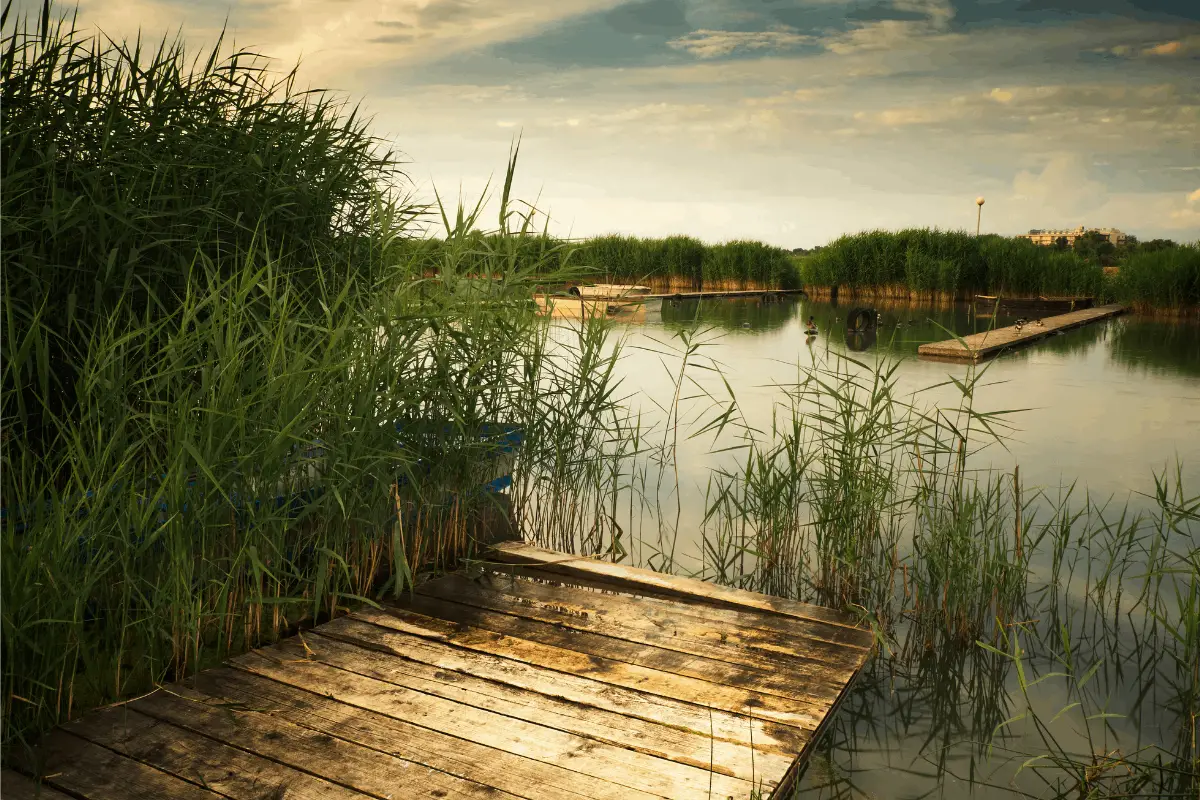Summer bass fishing can be challenging since many of the big fish head offshore to cooler water. These lures will help you unlock the key to those hiding places.
The key to catching summer bass is finding them. These 5 lures not only locate summer bass, but they excel at catching those lunkers. Anglers should have the following baits in their summer repertoire. Deep diving crankbaits, jigs, big walking baits and buzzbaits, drop shot lures and a punch rig.
In this article, I will break down each of these lures, where they are best utilized, and the types of cover each excels at.
Summer Bass Fishing
The cold weather is finally gone. Bass should be everywhere. Right?
There are always fish to be found shallow, but a large percentage of bass will move offshore and find cooler temperatures in the depths.
When beating the bank in July, August, and September, many bass enthusiasts are parking the boat right over the top of big schools and casting to empty water.
Effective summer lures need to not only catch fish, but locate them.
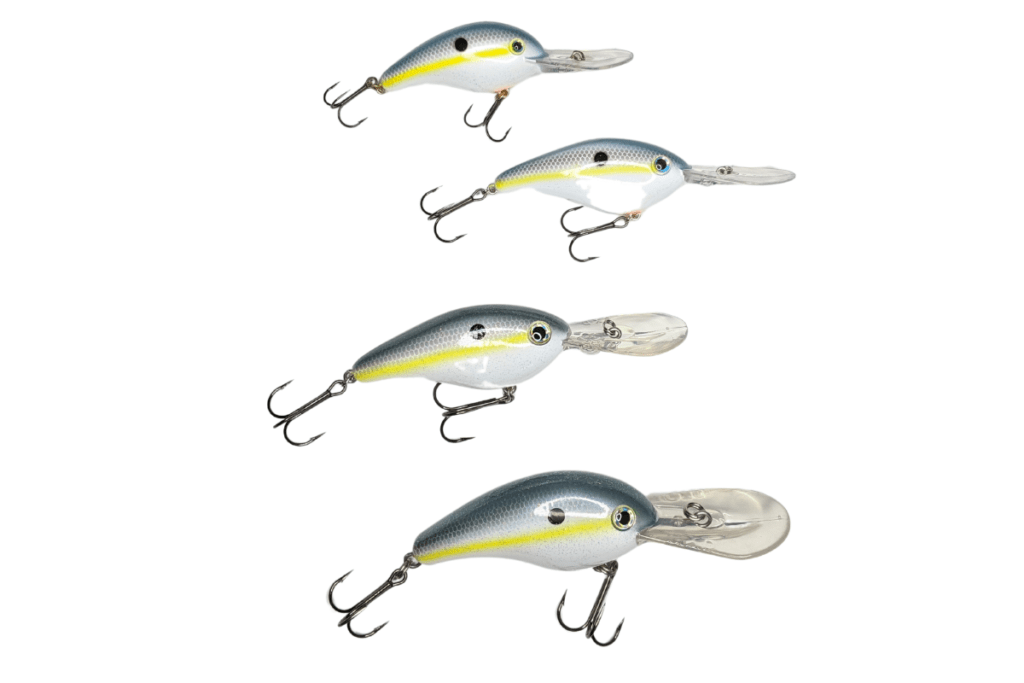
Deep Diving Crankbaits
The venerable crankbait may be the perfect combination of locating and catching bass in the heat.
These lures come in a variety of models that cover the entire water column clear down to 20+ feet. Diehard crankbait anglers will have boxes full of lures that hit each potential target zone.
Hit the Bottom, or at Least Hit Something
Whenever possible, crankbaits should be digging into the bottom of the lake or river.
The erratic deflections caused by banging into rocks, stumps, and other debris can trigger sluggish bass into reacting. There are times when those big lunkers are not in a feeding mood, but a crankbait banging around will force their instinct to take over and swallow that lure.
If the water you are fishing is thick with vegetation, there may not be the opportunity to make bottom contact.
In that situation, it is best to select a model that will touch the tops of the weeds so you can rip them out. This tearing and slashing movement draws the same type of reaction strikes that hitting the bottom does.
The Right Rod and Long Casts
Deep diving crankbaits take time to get to depth. Most often, anglers miss the target zone by not casting far enough.
A rod designed for crankbait fishing, one that is composite as opposed to straight carbon-fiber, has more flex and whip. I also prefer a crankbait rod that is 7’6” in length to apply additional leverage that way as well.
Cast well past the intended target.
This will ensure that the bait is digging into the zone you want to hit by the time it gets there.
Line Choice
Using the right line can make a huge difference in how far the bait will dive.
Many crankbait aficionados prefer to use straight fluorocarbon in the 10-12lb test range. Fluoro sinks and will let the deep diver get to its maximum potential depth.
Search, Search, Search . . . then Catch!
Our mindset needs to shift when fishing deep diving crankbaits in the summer.
This type of fishing involves a lot of searching before the catching can take place. The exciting part is that there may be a lot of catching when you find them.
Bass tend to school up when they are offshore. It is not unusual once the fish are found that an angler can sit on that school and catch fish on almost every cast. This flurry may last ten minutes or thirty. It depends on the size of the school and how pressured they feel.
For anglers that are willing to spend an hour or two in search mode, the reward can be significant.
Once the feeding frenzy dies down, throwing a follow-up presentation like a Carolina Rig, can get them active for a second round of action.
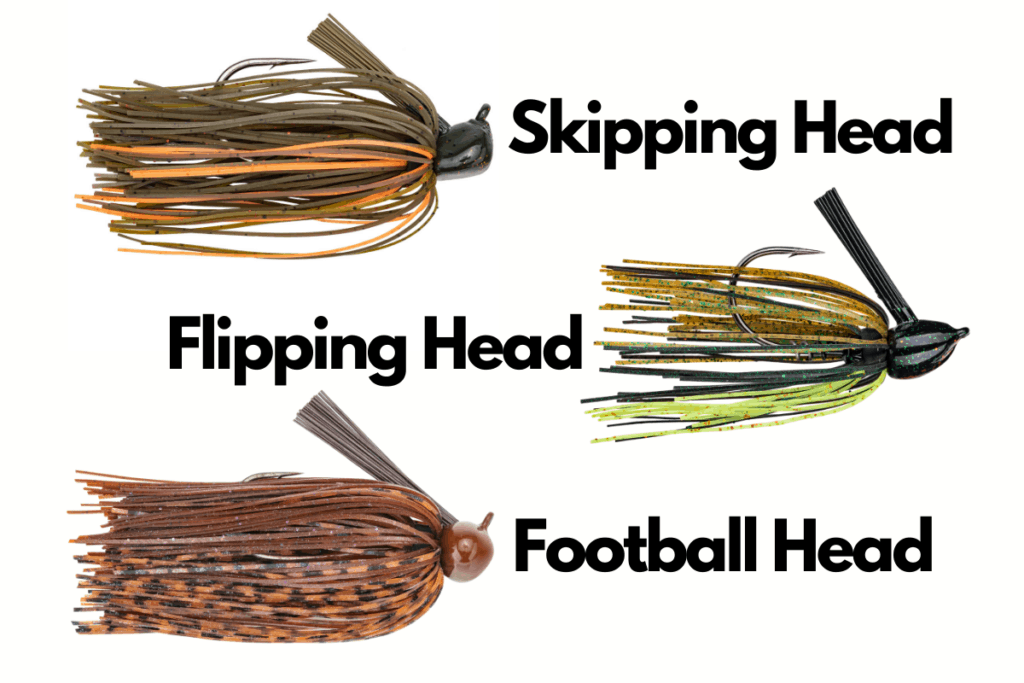
Jigs
When fish are relating to bottom structure and buried in thick cover, jigs may be one of the best lures a bass angler can throw.
Bass jigs have long been considered a big fish lure and many top pros have made entire careers throwing them. In recent years, the options available for jigs have become quite extensive. Different head designs are meant to be used in different types of situations.
Football Head
If the lakes or rivers you fish are primarily a hard, rocky bottom composition, it is hard to choose a better head design than this.
The football head is elongated to keep the jig from getting wedged into the cracks and crevices of the rocks. The additional surface area also makes for better sensitivity when used on a straight drag.
The football head also has a different sound than other head designs. Once again, the additional surface area is responsible for this.
Skipping Head
While just about any jig can be skipped across the surface of the water, there are special skipping jigs with a flat side.
The idea is to give a better sliding action across the surface of the water.
While many summer bass go deep, there are those fish that will remain shallow and seek out shade in heavy cover. This can include overhanging limbs and docks. A skipping jig is the ideal tool to reach those bass that are buried way underneath this cover.
Flipping Head
There are numerous jigs designed to flip or pitch into brush, vegetation, and rocks. A flipping style head is meant to slide, or bounce, through the cover and make its way to the bottom.
Most flipping jigs also work well when being dragged across the lake or river bed.
There are some flipping jigs with an almost perfectly round head design. These lures fall straight down on slack line.
A round flipping jig head is my goto lure choice when targeting bass suspended on dock pilings.
The Right Jig Rod
There are two main uses for a jig – dragging across the bottom and pitching into heavy, shallow cover.
Each method does best with a rod matched to the situation.
For dragging a jig I like to use a medium-heavy power rated rod. When pitching into nasty cover I opt for a heavy power rated rod with an extra fast tip.
When pulling bass out of the thick stuff, it is important to keep that fish coming right to the boat and not turning its head and burying deeper into the brush.
The Presentation
An excellent jig presentation for fishing deep, summer bass is to drag the lure along the bottom.
Cast the jig to your target, let it sink, and then pull the jig along by lifting the rod tip towards you. Think of it as raising the rod from the 8 o’clock position to about the 10 o’clock position. Reel the slack up when you dip the rod tip back down and repeat.
This dragging method keeps the angler in constant contact with the lure and bites are easier to detect.
Change the weight of the lure if needed. If you cannot feel the bottom go with a heavier jig. If the lure keeps getting hung up, go with a lighter version.
For flipping and pitching, it is important to let the jig fall on a slack line. Dip the rod tip as the lure enters the water to ensure it falls straight down.
When the jig hits bottom, hop it once or twice, reel it in quickly and repeat.
When targeting thick shoreline cover in the summer, it is a game of percentages. The more casts you make to likely targets, the more apt you are to get a bite.
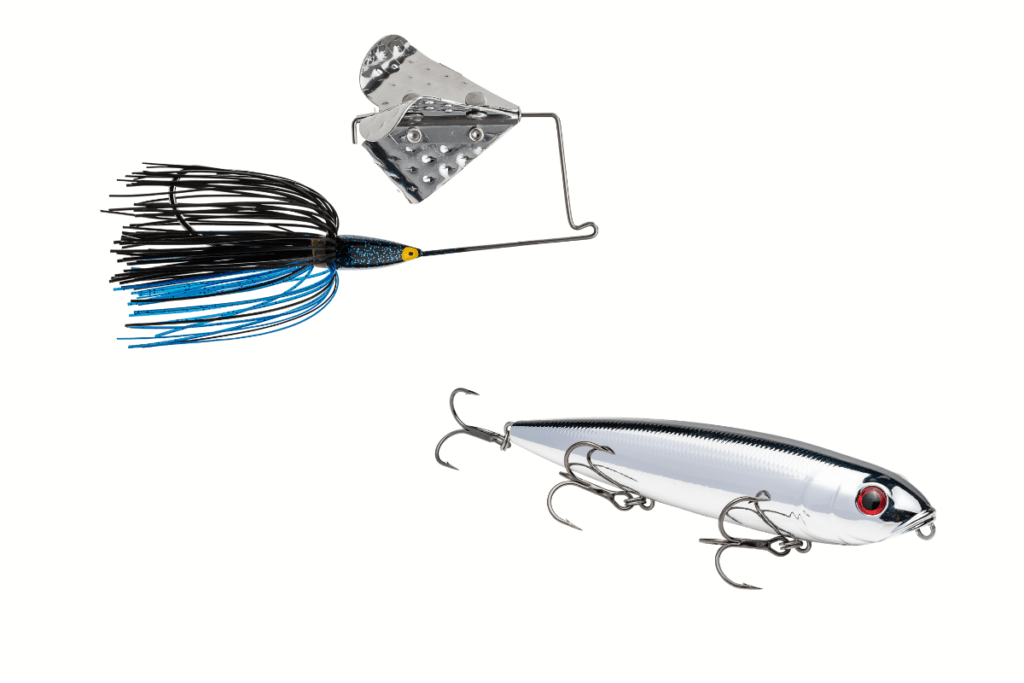
Summer Topwaters
There are a wide range of topwater lures that can be used to locate and catch summer bass, but two of the best are big walking lures and buzzbaits.
These two popular offerings give anglers the option to fish over more open, deeper water to call bass up and also hit tight shoreline cover.
Walking Bait
The traditional walking bait, like a Zara Spook or Sexy Dawg, is an excellent open water option.
It can be fished parallel to the shoreline and draw fish from cover. It can also be used out in the middle of the lake to pull up suspended fish or bass that are hunkered down well offshore.
The larger the bait, the greater the calling distance. Larger walking baits also are more effective on windier days when there is some chop on the water.
Buzzbait
A buzzbait is synonymous with summer bass fishing.
Most anglers think of it as only an early morning or evening option, yet the buzzbait will trigger strikes all day in the summer.
As the sun climbs higher in the sky, focus on fishing the buzzbait around cover that offers the most protection from the heat. Working it over the top of weed beds or along brush and docks is an excellent way to pull bass out of that protective shade.
Using a plastic trailer, or a trailer hook, will help improve the hookup ratio. Often the fish target the blades and will miss the business end of the lure.
A soft plastic trailer will pull their attention away from the blades and towards the hook. A stinger, or trailer hook, will not attract them, but it will increase the odds of getting solid penetration.
Presentation
Be sure to vary the cadence with each lure to decipher what the bass want on that particular day.
Speed it up and slow it down.
With the walking bait, add in a pause every-so-often. When fishing the buzzbait, twitch the lure and make the blades spit up some extra water.
When the bass start to commit with a solid bite you know you are working the lure effectively. If they keep missing or short-striking, vary the retrieve until it is dialed in.
Have a follow-up lure, like a wacky rigged stickbait, ready to toss in after a missed strike as well.
Drop Shot Rig
This might be my number one choice when fishing in the summer when the days are hot with intense sun beating down.
It is an effective lure to convince finicky bass to bite even on the most difficult days.
The rig is not only dynamite when fishing vertically, but it is also a great cast-and-retrieve method. Choosing natural colors and suspending the lure in front of bass can trigger strikes when nothing else will.
Power Shot
The power shot rig is a modified drop shot setup.
It uses heavier weights, ½ oz to 1 oz, so anglers can fish faster. The lure drops into position quickly. It can then be twitched a couple of times and then reeled back in to make another cast.
The power shot rig is an excellent fish locating tool that allows anglers to cover a lot of water while still presenting a finesse lure.
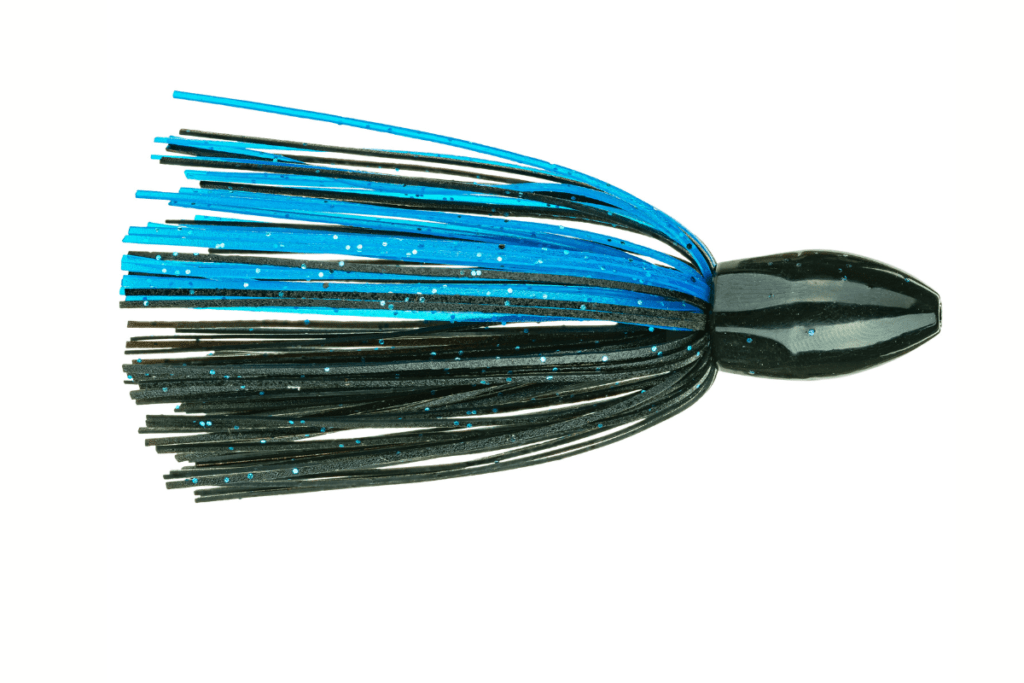
The Punch Rig
When bass remain shallow in the heat of summer, they will seek out shade.
This type of refuge from the heat often can be found in the form of matted vegetation. The thick stuff can be any form of grass depending on the part of the country you are from.
Thick mats can also come in the form of pockets that are full of debris like timber.
Most standard bass fishing tackle will not penetrate and get to the bass hanging out below.
A punch rig can.
There are several versions and methods used, but essentially it incorporates a very heavy weight in the 1 oz to 1 ½ oz range.
The weight will “punch” through the cover and let the soft plastic fall without hanging up. Most anglers will let the lure hit bottom, twitch it a couple of times and then pull the lure up to the matted vegetation and twitch it a couple of more times.
Reel it in an move on to the next cast.
If the water is stained to dirty, using a heavy braided line is the ideal choice for maximum winching power.
There are special setups, like the Slither Rig from Strike King, that are made specifically for punching. If you use a traditional worm weight and Texas rig, be sure to peg the weight so the lure will follow it down to the bottom. A free-sliding worm weight may punch through, but not pull the lure with it.
Final Thoughts
Summer fishing can be more challenging than we would like it to be.
Learning what lures and presentations can pull those lunkers from the depths or the shade can turn an average outing into a memorable one.
- Deep Diving Crankbait
- Jigs
- Walking baits and Buzzbaits
- Drop Shot Rig
- The Punch Rig
Each of these above-mentioned lures and tactics are proven summer powerhouses.
Tight lines. Be safe and make sure to encourage someone today. You never know how you may change their life forever.
Isaiah 6:8

